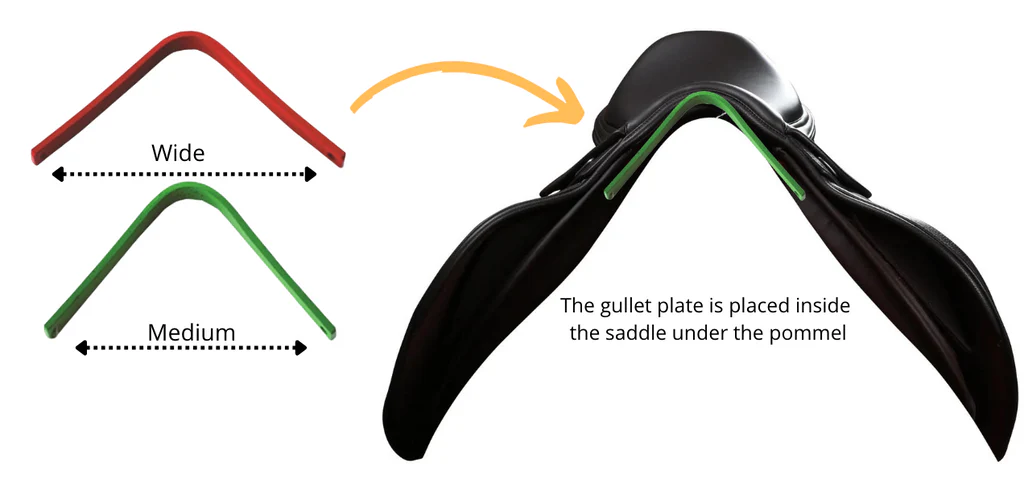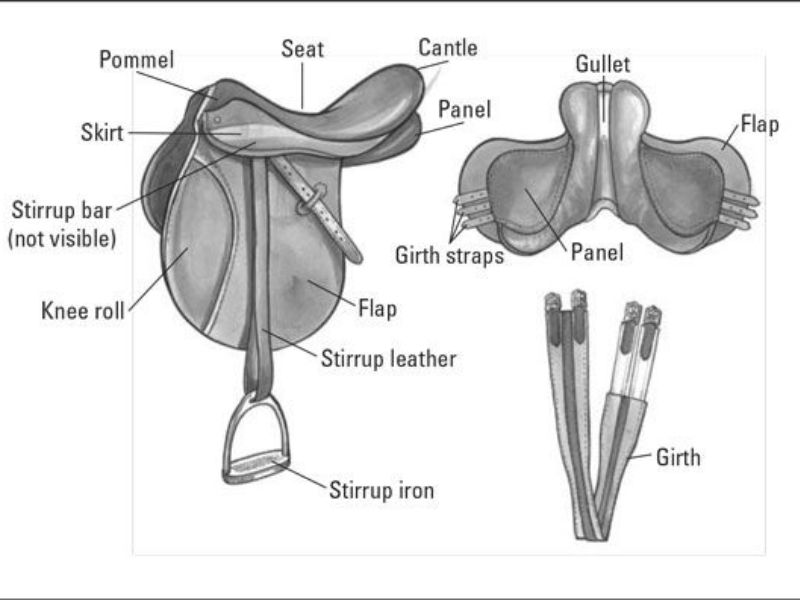When you purchase your first saddle, you have no idea what a gullet is or why it matters. But as time passes, you get to know that this one space or gap can affect the horse’s comfort, rider’s comfort, and the overall balance of the ride.
The gullet is a channel that works inside the saddle, located just above the horse’s withers. It’s a piece of equestrian gear that helps in weight distribution and allows the saddle to sit properly on the horse’s back.
Now, due to modernisation and innovation, many saddles come with the option of adjustable gullets. So as the horse changes shape, it becomes easier to adjust the gullet plate or the bar to maintain an ideal equine fit. An ideal gullet is like a bent metal bar or a coat hanger that can be adjusted based on your horse’s frame.
Whether you are an experienced rider or a new horse owner, this article will help you understand where the gullet fits and why it matters. After reading the article, you will get a clear idea of why gullets are key in creating a healthy connection between a rider and the horse’s movement.
What is the Gullet on a Saddle?
When you buy a new saddle, you see a small space under the pommel which is called the gullet. This tunnel-like part, located at the center above the horse’s spine, can affect the fit, comfort, and balance of both the rider and the horse.
If it is not fitted correctly, it can put pressure on the backbone and withers, which can cause serious pain, rubbing, and even long-term damage to the horse’s back. Horse owners struggle to understand how gullets work and often deal with ill-fitting saddles.
The gullet width should match the body type of your horse. It is important to measure your gelding’s back before buying a saddle. It helps in getting the right seat size, bar angle, and bar channel that distribute the weight and improve the horse’s movement.
Getting help from an experienced saddle fitter or looking at a photo guide for the correct gullet size can make the process easier. Today, the saddle industry and saddle makers try to make universal saddles that can fit every horse.
Some saddles come with a metal bar, which is bent like a coat hanger, in the gullet. Knowing about the angles is a key aspect when purchasing multiple saddles.

Why Gullet Width Matters for Saddle Fit
Gullet width plays an important role in saddle fit and horse comfort. It is a spinal channel that creates a clearance over the horse’s spine and withers. If this space is too narrow, it can put pressure on sensitive areas, leading to uneven weight distribution and discomfort..
A balanced gullet allows spinal clearance and gives room to the muscles along the back and shoulder to move freely. This freedom of movement improves performance and keeps the horse relaxed under the saddle. The perfect gullet clearance keeps the pressure evenly spread and reduces strain on the back.
If the gullet width is wrong, it can cause sore backs, stiff movements, and even behavioral issues. So choose a saddle that suits your horse’s bar angle, body shape, and spinal anatomy.
How to Measure Saddle Gullet Width
It is important to measure the gullet width of your saddle to keep your horse fit and comfortable. An ill-fitting gullet size results in poor spinal clearance, which can lead to long-term soreness or discomfort. Whether you are riding an English or Western saddle, the following methods and tools will help you measure accurately.
First, let’s talk about the tools you will need:
- A flexible curve ruler or gullet gauge
- Measuring tape
- A flat surface and a standing horse
Tools like a gel pad or wither tracing stick also help when measuring unique shoulder shapes or breeds like Arabians, Paints, or Draft Horses.
Step-by-Step Guide (Western vs English)
Step 1: Locate the Withers
First, you need to find the horse’s withers and then place the flexible ruler to fit along the spine and shoulder. This is a crucial part of ensuring wither clearance.
Step 2: Mark the Curve
Next, remove the ruler carefully and trace the curve. It shows the tree angle and helps determine whether your saddle bars are semi, full, or extra wide.
Step 3: Use a Gullet Measurement Guide
After locating and marking, use a gullet measurement guide to compare the shape with common sizes like 4.5″, 5″, 6″, or even 7″. Match it with your saddle’s dot-to-dot measurement (the space between the conchos at the front fork).
Step 4: Match to Saddle Type
Western saddles often use semi-quarter, quarter, or full bars, while English saddles are labeled as narrow, medium, wide, or XX-wide. Be aware that panel shape, tree design, and pommel height vary between types.
Gullet Width Chart
| Gullet Size | Inches (Dot-to-Dot) | Fit Type | Common Breeds |
|---|---|---|---|
| Narrow | 4.5″ – 5″ | Slim builds | Arabians, Thoroughbreds |
| Medium | 5″ – 6″ | Average builds | Quarter Horses, Paints |
| Wide | 6″ – 6.5″ | Broad backs | Warmbloods, Mustangs |
| Extra Wide | 6.5″ – 7″+ | Draft types | Draft Horses, Cobs |
You need to understand that every horse has different withers, spine shape, and muscle development. Also, keep in mind to check each saddle brand’s guidelines, because some manufacturers use slightly different sizing charts.
Always test your measurement with your actual saddle. Place it on your horse and check for clearance at the withers, tightness near the pommel, and ensure it doesn’t pinch or create uneven pressure along the spine or panel edges.
A properly fitted saddle improves your horse’s balance, supports better riding posture, and keeps your horse comfortable.

Gullet Size vs Tree Size: Are They the Same?
Gullet size is an open channel beneath the saddle’s pommel. It is placed over the horse’s withers and spine. It is used to provide spinal clearance and protect sensitive areas during movement and riding.
Saddle tree size is the internal structure of the saddle, which includes the bars, front arch, side panels, and overall length. It is used to distribute the rider’s weight, so it sits level and secure on the horse’s back.
While the gullet is part of the tree, they are not interchangeable terms. A wide gullet doesn’t guarantee a wide saddle tree, and relying only on gullet width can lead to poor fit. The bar angle and tree width should match the horse’s conformation, especially for horses with wide spines and narrow shoulders.
Some saddles give the option of interchangeable gullet plates, but the tree itself is usually fixed. So you can adjust the front width but cannot change the tree size without professional help.
It is important to measure both the gullet and tree size before selecting a saddle because they both help in better pressure distribution, comfort, and freedom of movement.
Signs Your Saddle Gullet Doesn’t Fit Your Horse
There are some physical and behavioral issues that your horse can face due to a poorly fitting gullet. When your horse starts pinning its ears, tossing its head, and showing reluctance to move forward, it means that the saddle is not fitted correctly.
You can also notice some physical signs like white hairs, dry spots, or uneven sweat patterns under the saddle area. These physical signs can point to pressure points or bridging, where the saddle makes uneven contact and creates sore spots. If you do not fix the gullet, it can compress soft tissue and cause long-term health issues like muscle atrophy.
When the saddle tips back and forth rather than sitting flat, it is called saddle rocking. It means the gullet doesn’t match your horse’s spine shape, which is causing uneven weight distribution and discomfort.
Adjustable Gullets: Are They Worth It?
Now, many saddles have the option of adjustable gullets. They use interchangeable gullet plates or a gullet bar system that allows owners to change the width of the saddle. These saddles are mostly used by riders with growing horses or owners with multiple horses.
They have some pros like the ability to customize the fit, better adaptability during seasonal weight changes, and easier resale. However, adjustable tree saddles still have limits — the saddle tree itself remains fixed, so changes are mostly confined to the front width, not the entire structure.
These adjustable gullets are best for horses who are still developing. But professional saddle fitting is best for horses with very specific conformation needs.

Western vs English Saddle Gullets: Key Differences
Both English saddles and Western saddles serve the same purpose: to protect the spine and distribute the rider’s weight. But they differ in gullet width and tree design.
Due to full bars and flatter trees, Western saddles are best for stockier horses like Quarter Horses. They usually come with wider gullets that range between 6.5 to 8 inches.
English saddles come with narrower gullets, usually between 2 to 4 fingers wide. They are best for Thoroughbreds and Warmbloods because they are shaped for higher withers and narrow shoulders.
Due to longer bars and a solid horn, the tree structure of Western saddles is ideal for trail riding, ranch work, or barrel racing. English saddles focus on freedom of movement, which makes them ideal for disciplines like dressage or show jumping, where shoulder rotation is key.
So, choosing between them depends on your needs and your horse’s build. The perfectly matched gullet increases performance and comfort for your horse.
Choosing the Right Gullet Width for Your Horse
It is very important to consider your horse’s breed, wither shape, and back profile before choosing the gullet.
- Shires and Clydesdales often require extra-wide gullets (7.5″ or more)
- Quarter Horses usually do well with a Full QH Bar (~6.75–7″)
- Arabians may need medium to wide gullets with more spinal clearance
Using a trial-and-error method is common, especially when testing saddles with interchangeable gullet systems. But if you’re unsure, it’s best to call a certified saddle fitter.
They’ll assess your horse’s spinal anatomy, shoulder angle, and muscle development to recommend the correct size.
Expert Tips for Proper Saddle Fit & Gullet Comfort
There are some pro tips that you can use to ensure that your saddle’s gullet fits perfectly:
- Wither tracings: To trace the horse’s withers and back shape, you can use tools like a flexible ruler. It helps in getting accurate measurements when selecting gullet widths.
- Saddle pad effect: Saddle pads also play an important role in saddle width, so always evaluate the saddle and pad together.
- Seasonal body changes: A horse’s body changes throughout the year as they gain or lose weight. So it’s vital to recheck gullet fit in summer and winter to avoid hidden pressure buildup.
- Pommel, cantle & tree check: The gullet fit works collectively with other parts of the saddle. The pommel should offer wither clearance, the cantle should sit level, and the tree should follow the horse’s back line smoothly.
Following these tips ensures a comfortable ride for both horse and rider.
